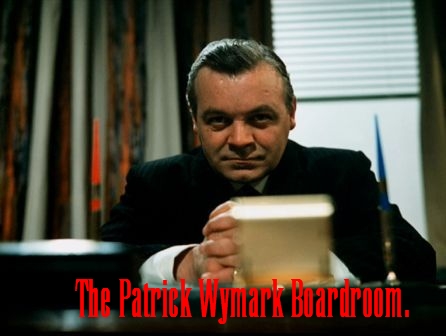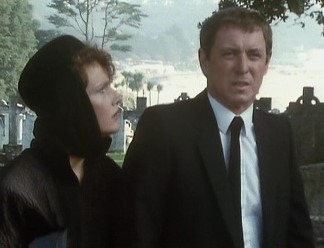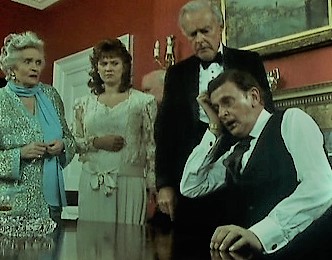
Bergeracís Island Ė Jersey in the 1980ís
Exhibition at Jersey Museum and Art Gallery 2017.
by Harry Dobermann
Bergerac, the 1980ís BBC crime series, is commemorated in a new exhibition at Jersey Museum which contrasts the history of the island with the TV series. Well designed and informative, there is certainly enough information to keep visitors occupied for a couple of hours with a surprising depth of detail, both about the TV series and Jersey itself.

Bergerac was created by Robert Banks Stewart in 1981 Ė the third attempt by the BBC (after Target starring Patrick Mower and Shoestring starring Trevor Eve) to generate a then-revolutionary film series in the vein of ITVís Euston Films. Where Target had been a straightforward knock-off of Eustonís The Sweeney, Stewart had attempted with Shoestring to emulate the commercial, but character-driven plots of the better US TV shows. While he succeeded in creating a commercial hit, he was faced with creating a replacement when Trevor Eve declined to commit to a third series . Where the previous two series had been set in Bristol, Stewart chose to set Bergerac on the island of Jersey, a self-governing Crown dependency with a states police force supporting a historic system of elected Parish police. With its low tax and duty rates, the island attracted a breed of gold-necklace millionaires who could provide the colourful background for a glamourous crime series. As in Hawaii 5-0 the series focused on a fictional police unit, the Bureau des Etrangers which dealt with the wealthy visitors to the island.

Susan Young (Louise Jameson) & Jim Bergerac (John Nettles) in St Breladeís Churchyard.
In a bid to maintain the high Sunday evening viewing figures of the previous show, Stewart replicated the Shoestring format of a large running cast of Bergeracís colleagues and family. Bergerac himself seemed to have been assembled by computer. Actor John Nettles had previously been in contention for the role of ITVís Hazell (played by Nicholas Ball), and
Bergerac surprised the BBC by becoming a bigger hit than Shoestring. Stewart left after the first two series, replaced by experienced drama producer Jonathan Alwyn (who had produced ITVís Enemy At The Door about occupied wartime Guernsey). Together with script editor Chris Boucher, he steered the series until 1991, providing Jersey Tourism with a poster boy in the shape of John Nettles. Within its established format, Bergerac covered a wide range of plots from political thrillers such as Avenge O Lord (reuniting Secret Armyís Bernard Hepton and Terrence Hardiman in very different roles) to the supernatural Boxing Day 1986 special Fires in the Fall in which Margaretta Scott and Amanda Redman are haunted by a hooded figure to which Barrie Inghamís prophetically-named* medium Raoul Barnaby may hold the key.
* Prophetic for John Nettlesí future career that is .

Margaretta Scott, Amanda Redman, Terence Alexander & Barrie Ingham in Fires in the Fall
Bergeracís Island Ė Jersey in the 1980ís uses the theme of Bergerac to relate the recent history of Jersey. Kicking off with a new video introduction from John Nettles, the exhibition gives us a taste of the TV series before reminding us that this was still the era of the Cold War. Jerseyís nuclear survival effort would ironically have been huddled in a German communications bunker left over from the Occupation.
Not surprisingly, the exhibition deals with crime on the island, but also covers the Great Storm, showing buildings with roofs torn away, and displaying the helmet of a fireman which protected him from a blow by a flying tree.
The exhibition covers entertainment and the holiday season, showing videos of the days when Fort Regent was an entertainment hotspot with its own cable car service. It also highlights some darker, less-publicised memories such as the fact that the island once had its own problem housing estate where taxi drivers refused to call. Photoís of food shortages and cancelled ferry services also illustrate the precariousness of the island economy before it was boosted by financial services. The farmhouse which Bergerac lived in for the first three series was located in a valley which was later flooded to provide more water for the increasingly crowded island. The exhibition covers the protests against the flood plan including a video of conservationist David Bellamy leading a protest march.

The exhibition constantly references back to the TV episodes contrasting reality with fiction, and also includes a fascinating slideshow of behind-the-scenes shots (my favourite is a photo of John Bluthal and a young long-haired Tony Robinson playing an inept private eye passing himself off as Bergerac). There is also a vehicle which may or may not be Bergeracís vintage car.
The Exhibition was put together for Jersey Heritage by The Idea Works who certainly put a fantastic degree of work and imagination into the display. The typography and general design is reminiscent of The Face and Smash Hits and there is so much detail that you can easily lose a couple of hours in this one exhibition before visiting the rest of the museum. One of the most amusing features is the result of a competition where islanders were challenged to provide then-and-now recreations of their 1980ís snapshots. You can see more of the exhibition at The Idea Works website
Bergeracís Island runs until 31 December 2017 and can be found at Jersey Museum and Art Gallery, The Weighbridge, St Helier (normal admission prices apply)